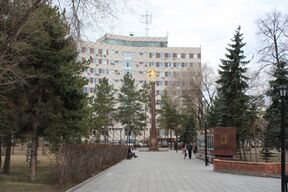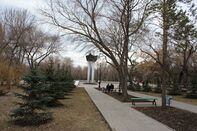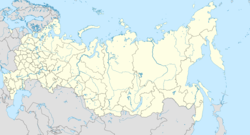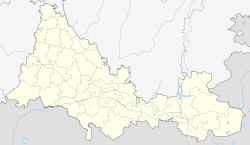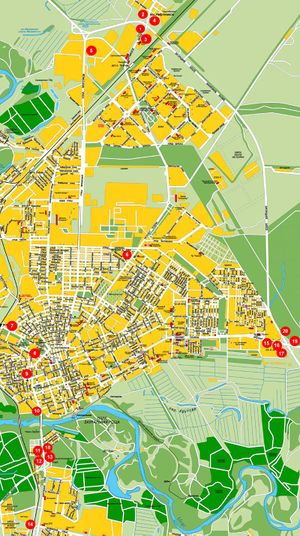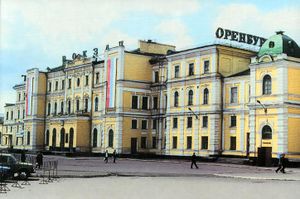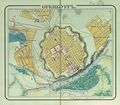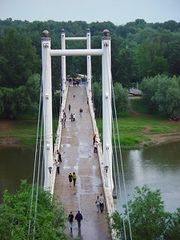أورنبورغ
{{ safesubst:#invoke:Unsubst||date=__DATE__|$B=
أورنبورگ
Оренбург | |
|---|---|
| الإحداثيات: 51°47′N 55°06′E / 51.783°N 55.100°E | |
| البلد | روسيا |
| الكيان الاتحادي | Orenburg Oblast[1] |
| Founded | 1743[2] |
| الحكومة | |
| • الكيان | دوما المدينة |
| • الرئيس | Sergey Salmin[3] |
| المساحة | |
| • الإجمالي | 259 كم² (100 ميل²) |
| التعداد | |
| • الإجمالي | 548٬331 |
| • الترتيب | 28 in 2010 |
| • الكثافة | 2٬100/km2 (5٬500/sq mi) |
| • Subordinated to | مدينة اورنبورگ[1] |
| • Capital of | اوبلاست اورنبورگ[1], منطقة اورنبورگسكي[6] |
| • Urban okrug | اوكروگ أورنبورگ الحضري[7] |
| • Capital of | اوكروگ أورنبورگ الحضري, منطقة أورنبورگسكي البلدية |
| Postal code(s)[8] | 460000 |
| Dialing code(s) | +7 3532 |
| الموقع الإلكتروني | www |
أورنبورگ/أورنبورغ (روسية: Оренбург; النطق الروسي: [ərʲɪnˈburk]، Orenburg) وكانت تُعرف سابقاً بإسم شكالوف Chkalov (1938-1957)، هي مدينة قارية ومركز اداري لأبلاست أورنبورگ، روسيا، وتقع على نهر الأورال على بعد 1478 كم جنوب شرق موسكو، على مقربة من الحدود مع قزخستان. عدد سكانها 548.331 (تعداد 2010)؛ [5] 549.361 (تعداد 2002)؛[9] 546,501 (تعداد 1989).[10]
أصل الاسم
Several historians have tried to explain the origins of the city's name. It was traditionally accepted that the word "orenburg" means a fortress on the نهر أور.[11] In all probability, the word combination "orenburg" was proposed by I. K. Kirillov, the founder of the city. In 1734, in accordance with his project, a package of governmental documents was worked out. This was the starting point for Orenburg as a fortress city near the meeting of the Or and Ural rivers.
On 7 June 1734, "A Privilege for Orenburg" (tsar's edict) was ordered by Empress Anna Ioannovna.
While the construction site of the main fortress changed many times (down the River Ural), the name "Orenburg" has not changed since its founding in 1743. Between 1938 and 1957, the city was referred to as Chkalov,[12][13] named after the famous Soviet pilot Valery Chkalov, although he was not born in and never lived in Orenburg, and never visited Orenburg. In 1954, Chkalov's five-meter bronze sculpture was erected on the occasion of his 50th birth anniversary; this was installed on a seven-meter pedestal on the Boulevard (the riverside promenade of the city, commonly named "Belovka").
التاريخ
In 1734, the Russian Empire began to expand its dominance and influence in Asia by building a fortified city called Orenburg on its eastern border (Southern Urals). For this purpose, in 1735, Ivan Kirilov, a cartographer and statistician, began to develop the settlement at the confluence of the rivers Or and Ural, and the first settlement was chosen during his expedition. He claimed that the town was needed "to open a transit route to Bukhara, Badakhshan, Balkh and India" and that "riches in the form of gold, lapis lazuli and garnets could be obtained from it". After his death, a new manager of the Orenburg expedition, Vasily Tatishchev, was appointed who did not consider the place suitable for building a city. Therefore, in 1739 he began preparations for the construction of a new town with the old name on Krasnaya Gora (Red Mountain), downstream of the Ural (Yaik)River. The old settlement was named the Orsk fortress (now the city of Orsk).[14]
On August 6, 1741, the new town was laid out. However, its construction never started. The place on Krasnaya Gora was not suitable for the construction of the city, as it was treeless, rocky and far from the river. A new manager of the Orenburg expedition Ivan Neplyuev was appointed, and on April 19, 1743, Orenburg was built up on the third attempt, at the place where the Berd settlement was earlier located, 75 km (46miles) from the Krasnaya Gora. In the summer of 1742, Neplyuev was assigned to build the city on the site of the rivers Yaik and Sakmara. The new place, surrounded by forests and fields where the Yaik and Sakumara rivers converge, was chosen by Neplyuev himself. Today it is the historical center of the city. The town built on the Red Mountain was named Krasnogorsk. Thus, in 1743 Ivan Neplyuev founded Orenburg on thesite of present-day Orsk, about 250 kilometers west of the Urals. This third Orenburg served as an important military outpost on the border with the nomadic Kazakhs. It became the center of the Orenburg Cossacks.
Orenburg played a major role in Pugachev's Rebellion (1773–1774), the largest peasant revolt in Russian history. At the time, it was the capital of a vast district and the seat of the governor. Yemelyan Pugachev besieged the city and its fortress from nearby Berda from October 1773 to March 26, 1774. The defense was organized by Governor of Orenburg lieutenant-general Reinsdorf.[15] General Golytsin defeated Pugachev at Berda, and later again at Kargala (north of Orenburg).[16] Most of the city was left in ruins, and thousands of inhabitants had died in the siege. Government forces crushed revolt towards the end of 1774 by General Michelsohn at Tsaritsyn. Further reprisals against rebel areas were carried out by General Peter Panin.
Alexander Pushkin visited Orenburg in 1833 during a research trip for his books The History of Pugachev and his famous novel The Captain's Daughter. He met his friend Vladimir Dal here, who would later write the first serious dictionary of the Russian language.
Orenburg was the base for General Perovsky's expeditions against the Khanate of Khiva in the 1830s through 1850s. After the incorporation of Central Asia into the Russian Empire, Orenburg became a trading station and, since the completion of the Trans-Aral Railway, a prominent railway junction en route to the new Central Asian possessions and to Siberia.
Orenburg functioned as the capital of the Kirghiz Autonomous Soviet Socialist Republic (in present-day Kazakhstan) within Russia from 1920 to 1925. When that republic was renamed Kazakh Autonomous Socialist Soviet Republic in 1925, Orenburg joined Russia and Kyzylorda became the new capital. Almaty became the capital in 1929 after the construction of the Turkestan–Siberia Railway. Kazakh Autonomous Soviet Socialist Republic was promoted to union republic status as the Kazakh Soviet Socialist Republic Kazakh SSR in 1936. Orenburg remained in Russia. From 1938 to 1957, the city bore the name Chkalov (Чка́лов) (after the prominent test pilot Valery Chkalov). The city's distance from the German invasion during World War II led many Soviet enterprises to flee there, helping to spur the city's economic growth.
الوضع الإداري والبلدي
| السنة | تعداد | ±% |
|---|---|---|
| 1897 | 72٬000 | — |
| 1926 | 122٬190 | +69.7% |
| 1939 | 171٬726 | +40.5% |
| 1959 | 267٬317 | +55.7% |
| 1970 | 344٬266 | +28.8% |
| 1979 | 458٬747 | +33.3% |
| 1989 | 546٬501 | +19.1% |
| 2002 | 549٬361 | +0.5% |
| 2010 | 548٬331 | −0.2% |
| 2021 | 543٬654 | −0.9% |
| Source: Census data | ||
Orenburg is the administrative center of the oblast[1] and, within the framework of administrative divisions, it also serves as the administrative centre of Orenburgsky District,[6] even though it is not a part of it.[17] As an administrative division, it is, together with ten rural localities, incorporated separately as the City of Orenburg[1]—an administrative unit with the status equal to that of the districts.[بحاجة لمصدر] As a municipal division, the City of Orenburg is incorporated as Orenburg Urban Okrug.[7]
الجغرافيا
تقع المدينة على مجرى نهر سكمارا والأورال. أعلى نقطة بالمدينة تقع على ارتفاع 154.4 متر.[بحاجة لمصدر]
الاقتصاد
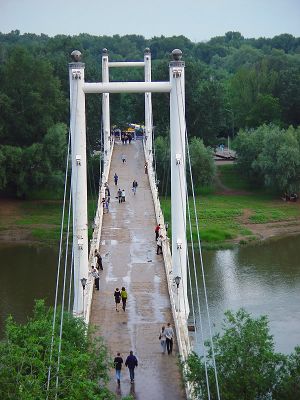
Orenburg is home to several large companies or their subsidiaries: Orenburggazprom,[18] the subsidiary of Gazprom; Orenburgneft,[19] the subsidiary of TNK-BP oil company; Orenburgenergy, one of the biggest energy generating companies in Russia.
النقل
Orenburg has been a major railway centre ever since the Samara-Zlatoust and Orenburg-Tashkent railroads were completed, respectively in 1876 and 1905.[20] Orenburg's main airport is the Orenburg Tsentralny Airport,[21] located about 25 كيلومتر (16 mi) east of the city, on the Orsk destination, and used to be the headquarters of now defunct Orenair.[21] City public transport includes bus, trolleybus and also marshrutkas (fixed-route cabs).
المناخ
Orenburg has a relatively dry humid continental climate (Köppen climate classification Dfa) with quite long and hot summers and long and cold winters. April and October are transition months, with the rest of the months being either summer or winter.
| بيانات المناخ لـ أورنبورگ | |||||||||||||
|---|---|---|---|---|---|---|---|---|---|---|---|---|---|
| الشهر | ينا | فب | مار | أبر | ماي | يون | يول | أغس | سبت | أكت | نوف | ديس | السنة |
| القصوى القياسية °س (°ف) | 4.7 (40.5) |
5.8 (42.4) |
18.9 (66.0) |
31.3 (88.3) |
36.5 (97.7) |
39.8 (103.6) |
41.6 (106.9) |
40.9 (105.6) |
38.0 (100.4) |
27.0 (80.6) |
19.2 (66.6) |
8.1 (46.6) |
41.6 (106.9) |
| متوسط القصوى اليومية °س (°ف) | −8 (18) |
−7.2 (19.0) |
−0.8 (30.6) |
12.8 (55.0) |
22.1 (71.8) |
27.5 (81.5) |
29.0 (84.2) |
27.4 (81.3) |
20.9 (69.6) |
11.2 (52.2) |
0.3 (32.5) |
−5.9 (21.4) |
10.78 (51.40) |
| المتوسط اليومي °س (°ف) | −11.8 (10.8) |
−11.5 (11.3) |
−5.2 (22.6) |
6.9 (44.4) |
15.2 (59.4) |
20.6 (69.1) |
22.3 (72.1) |
20.3 (68.5) |
14.0 (57.2) |
5.9 (42.6) |
−3.2 (26.2) |
−9.5 (14.9) |
5.3 (41.6) |
| متوسط الدنيا اليومية °س (°ف) | −15.5 (4.1) |
−15.7 (3.7) |
−9.3 (15.3) |
1.7 (35.1) |
8.5 (47.3) |
13.8 (56.8) |
15.6 (60.1) |
13.6 (56.5) |
7.9 (46.2) |
1.6 (34.9) |
−6.1 (21.0) |
−13.1 (8.4) |
0.3 (32.4) |
| الصغرى القياسية °س (°ف) | −43.2 (−45.8) |
−40.1 (−40.2) |
−36.8 (−34.2) |
−26 (−15) |
−5.7 (21.7) |
−0.7 (30.7) |
4.9 (40.8) |
−0.9 (30.4) |
−5.3 (22.5) |
−19.8 (−3.6) |
−35.7 (−32.3) |
−39.2 (−38.6) |
−43.2 (−45.8) |
| متوسط تساقط الأمطار mm (inches) | 29 (1.1) |
22 (0.9) |
25 (1.0) |
28 (1.1) |
30 (1.2) |
36 (1.4) |
41 (1.6) |
29 (1.1) |
26 (1.0) |
34 (1.3) |
33 (1.3) |
31 (1.2) |
364 (14.3) |
| [بحاجة لمصدر] | |||||||||||||
العسكرية
توجد قاعدة جوية على بعد 5.6 جنوب غرب المدينة.
التعليم والثقافة
تعتبر المدينة المركز الاقليمي للتعليم ويوجد بها عدد من المؤسسات الثقافية والمتاحف.
التعليم
تضم المدينة المؤسسات التعليمية التالية:
- جامعة اورنبورگ الحكومية
- الأكاديمية الطبية الحكومية في اورنبورگ
- جامعة اورنبورگ الزراعية الحكومية
- Orenburg State Pedagogical University
- أكاديمية الحقوق الحكومية في موسكو، فرع اورنبورگ
- Orenburg Branch of Gubkin Russian State University of Oil and Gas
- Orenburg Campus of Russian State University of Trade and Economics
المتاحف
- متحف اورنبورگ المحلي للتاريخ والعلوم الطبيعية
- متحف اورنبورگ المحلي للفنون
- متحف اورنبورگ للتاريخ
- النصب التذكاري ليور وڤالنتينا گگارين
- النصب التذكاري لليوپول ومستيسلاڤ روتروپوڤيچ
- النصب التذكاري لت. ج. شڤچنكو
- البيت التذكاري لمدينة اورنبورگ
المسارح
- مسرح مكسيم گورجي للدراما [1]
- المسرح الموسيقي الحكومية المحلي في اورنبورگ [23]
- مسرح التتار الدرامي الحكومي في اورنبورگ
- مسرح العرائس الدرامي المحلي في اورنبورگ
- مسرح عرائس اورنبورگ
- Orenburg Municipal Chamber Choir
- Orenburg State Academic Russian Folk Choir
المساجد
السياحة
Mountain and river tourism are developed in the region. There are a number of fast mountain rivers and rocks in pleated spurs of the southern edge of the Urals range, popular with tourists. The city is known for its location between Europe and Asia. The Ural River marks the border of Asia and Europe, and there is a bridge which connects the two sides.
The city is famous for its down Orenburg shawls. The thinnest lacy design, knitted by hand shawls and cobweb-like kerchiefs (pautinkas), is not only warm, but also is used for decorative purposes.
العمارة
A famous boulevard on the embankment of the Ural River is one of the most notable places in Orenburg. Orenburg TV Tower is a guyed mast of unusual design. It is a 200-متر (660 ft) tall mast equipped with six crossbars running from the mast structure to the guys.[24]
الرياضة
تضم اورنبورگ الأندية التالية:
تكريمات
سمي على اسمها الكويكب 27709 اورنبورگ، في 1 يونيو 2007.†
مشاهير المدينة
- إيڤان كريلوف (1769–1844)، كاتب
- Vasily Alekseevich Perovsky (1794—1857)، رجل دولة
- ڤلاديمير دال (1801–1872)، معجمي
- Yevgraf Fyodorov (1853–1919)، رياضياتي، عالم بلورات، وعالم معادن
- Paul Nazaroff (1890–1942)، جيولوجي وكاتب
- يوسف كسل (1898–1979)، صحفي وروائي
- موسى جليل (1906–1944)، تاريخ
- Alexander Schmorell (1917–1943)، عضو في مجموعة الوردة البيضاء المناهضة للنازية
- ألكسندر بوربا (1918-1984)، رائد صناعي، ومعلم
- مستيسلاڤ راستروپوڤيتش (1927–2007)، عازف تشيلو
- يوري گاگارين (1934–1968)، رائد فضاء
- Denis Istomin (born 1986)، لاعب كرة مضرب
- گيورگي مالنكوف (1902-1988) زعيم حزب شيوعي
العلاقات الدولية
اورنبورگ على شقاقة مع المدن التالية:[25]
المصادر
الهوامش
- ^ أ ب ت ث ج ح Law #1370/276-IV-OZ
- ^ Из истории Казахстана XVIII в
- ^ "Администрация города Оренбурга". Официальный портал города Оренбурга. Retrieved 2022-06-29.[dead link]
- ^ Генеральный план Оренбурга. Материалы по обоснованию проекта. Раздел 4.1. Территория города. Стр. 29
- ^ أ ب Russian Federal State Statistics Service (2011). "Всероссийская перепись населения 2010 года. Том 1". Всероссийская перепись населения 2010 года (2010 All-Russia Population Census) (in Russian). Federal State Statistics Service. Retrieved June 29, 2012.
{{cite web}}: Invalid|ref=harv(help); Unknown parameter|trans_title=ignored (|trans-title=suggested) (help)CS1 maint: unrecognized language (link) - ^ أ ب قالب:OKATO reference
- ^ أ ب Law #2367/495-IV-OZ
- ^ Почта России. Информационно-вычислительный центр ОАСУ РПО. (Russian Post). Поиск объектов почтовой связи (Postal Objects Search) (in روسية)
- ^ Russian Federal State Statistics Service (May 21, 2004). "Численность населения России, субъектов Российской Федерации в составе федеральных округов, районов, городских поселений, сельских населённых пунктов – районных центров и сельских населённых пунктов с населением 3 тысячи и более человек" (XLS). Всероссийская перепись населения 2002 года [All-Russia Population Census of 2002] (in Russian). Retrieved August 9, 2014.
{{cite web}}: Invalid|ref=harv(help); Unknown parameter|trans_title=ignored (|trans-title=suggested) (help)CS1 maint: unrecognized language (link) - ^ "Всесоюзная перепись населения 1989 г. Численность наличного населения союзных и автономных республик, автономных областей и округов, краёв, областей, районов, городских поселений и сёл-райцентров.[[Category:Articles containing روسية-language text]] (All Union Population Census of 1989. Present population of union and autonomous republics, autonomous oblasts and okrugs, krais, oblasts, districts, urban settlements, and villages serving as district administrative centers.)". Всесоюзная перепись населения 1989 года (All-Union Population Census of 1989) (in Russian). Demoscope Weekly (website of the Institute of Demographics of the State University—Higher School of Economics. 1989. Retrieved 2007-12-13.
{{cite web}}: Italic or bold markup not allowed in:|publisher=(help); URL–wikilink conflict (help)CS1 maint: unrecognized language (link) - ^ Поспелов Е.М. Географические названия мира: топонимический словарь. — М.: Русские словари; Астрель; ACT, 2002. — ISBN 5-17-002938-1; 5-271-00446-5; 5-93259-014-9; 5-17-001389-2.
- ^ Оренбург — статья из Большой советской энциклопедии.
- ^ Город был переименован Указом ПрезидиумаПрезидиума Верховного Совета СССР от 26 декабря 1938 г.
- ^ С.М.Стрельников. Географические названия Оренбургской области. — Изд. 2-е, доп. и испр. — Кувандык, 2002. — 176 с.
- ^ Shane O'Rourke The Cossacks Manchester University Press, 2008 ISBN 9780719076800
- ^ Tatishchevo 1774 in Tony Jaques Dictionary of Battles and Sieges: P-Z ISBN 9780313335396
- ^ قالب:OKATO reference
- ^ "Gazprom". Archived from the original on أبريل 30, 2009. Retrieved أبريل 11, 2009.
- ^ "Orenburgneft". Archived from the original on مايو 3, 2009. Retrieved أبريل 12, 2009.
- ^ Correspondence, Foreign (November 7, 1904). "RUSSIA'S NEW GREAT RAILROAD IN ASIA; Orenburg-Tashkent Line Was Completed a Few Days Ago. GREAT VALUE STRATEGICALLY Prince Hilkoff Pushed the Construction of the Road with Much Energy -- The Cities Traversed" (PDF). The New York Times.
- ^ أ ب "Archived copy". Archived from the original on أبريل 3, 2009. Retrieved أبريل 12, 2009.
{{cite web}}: CS1 maint: archived copy as title (link) - ^ "Pogoda.ru.net" (in Russian). Retrieved September 8, 2007.
{{cite web}}: CS1 maint: unrecognized language (link) - ^ http://www.orenburg.ru/culture/theatre/
- ^ "Оренбург".
- ^ profile documents, Orenburg
المراجع
- Законодательное Собрание Оренбургской области. Закон №1370/276-IV-ОЗ от 11 июля 2007 г. «Об административно-территориальном устройстве Оренбургской области», в ред. Закона №1429/412-V-ОЗ от 7 мая 2013 г. «О внесении изменений в Закон Оренбургской области "Об административно-территориальном устройстве Оренбургской области"». (Legislative Assembly of Orenburg Oblast. Law #1370/276-IV-OZ of July 11, 2007 On the Administrative-Territorial Structure of Orenburg Oblast, as amended by the Law #1429/412-V-OZ of May 7, 2013 On Amending the Law of Orenburg Oblast "On the Administrative-Territorial Structure of Orenburg Oblast").
- Законодательное Собрание Оренбургской области. Закон №2367/495-IV-ОЗ от 15 сентября 2008 г. «Об утверждении перечня муниципальных образований Оренбургской области и населённых пунктов, входящих в их состав», в ред. Закона №1772/560-V-ОЗ от 30 октября 2013 г. «О внесении изменений в Закон Оренбургской области "Об утверждении перечня муниципальных образований Оренбургской области и населённых пунктов, входящих в их состав"». (Legislative Assembly of Orenburg Oblast. Law #2367/495-IV-OZ of September 15, 2008 On Adopting the Registry of the Municipal Formations of Orenburg Oblast and the Inhabited Localities They Comprise, as amended by the Law #1772/560-V-OZ of October 30, 2013 On Amending the Law of Orenburg Oblast "On Adopting the Registry of the Municipal Formations of Orenburg Oblast and the Inhabited Localities They Comprise").
وصلات خارجية
- Official website of Orenburg (بالروسية)
- Orenburg State Institute of Management
- Photos of Orenburg (بالروسية)
- Pages using gadget WikiMiniAtlas
- Articles with dead external links from February 2024
- CS1 errors: unsupported parameter
- Articles with روسية-language sources (ru)
- Articles containing روسية-language text
- CS1 errors: markup
- CS1 errors: URL–wikilink conflict
- CS1: Julian–Gregorian uncertainty
- Short description with empty Wikidata description
- Pages using multiple image with auto scaled images
- Coordinates not on Wikidata
- Articles with unsourced statements from November 2012
- Articles with unsourced statements from December 2011
- Articles with hatnote templates targeting a nonexistent page
- أورنبورگ
- Orenburgsky Uyezd
- أبلاست أورنبورگ
- أماكن مأهولة تأسست في 1743
- History of Ural
- 1743 establishments in the Russian Empire
- Transcontinental cities
- Cities and towns in Orenburg Oblast
